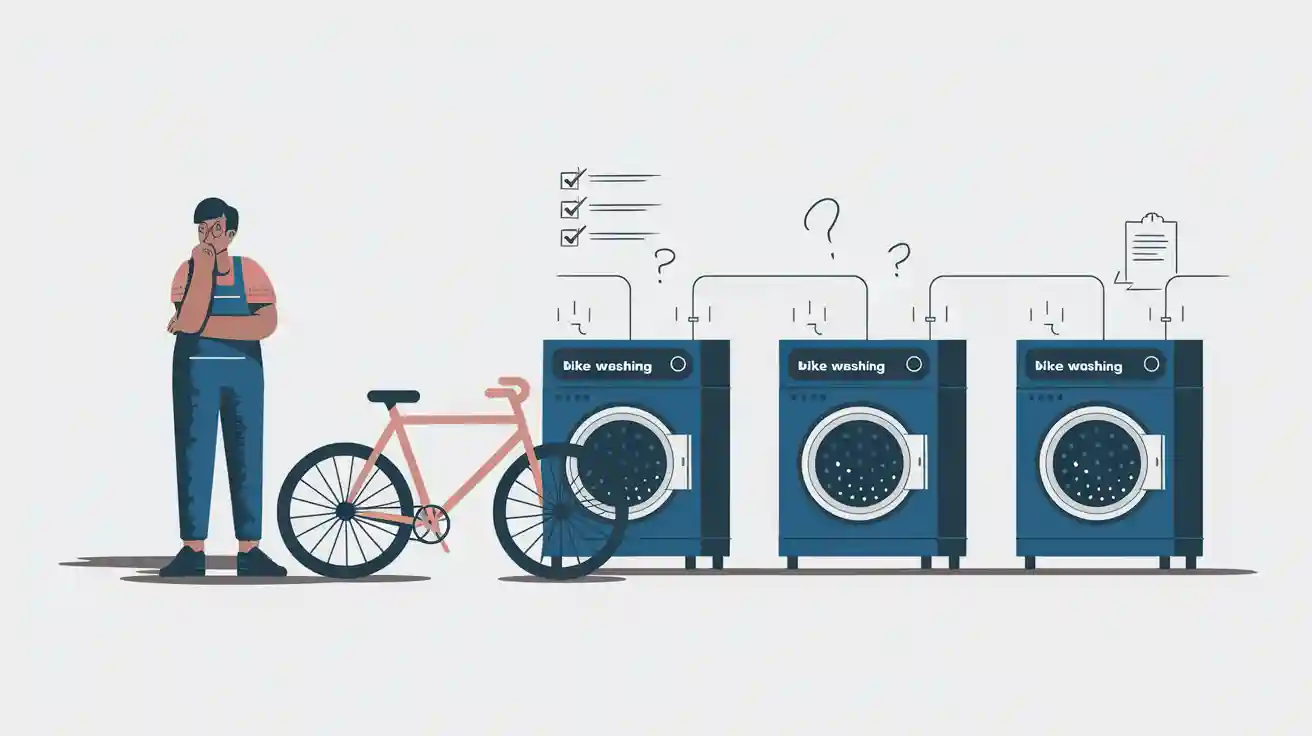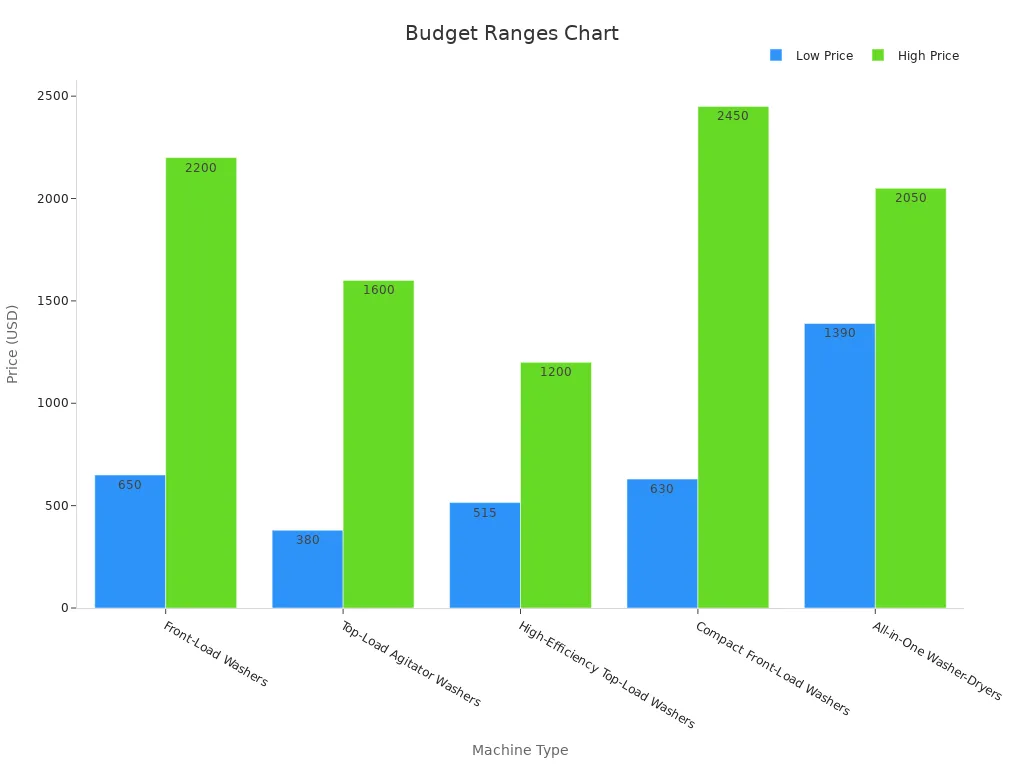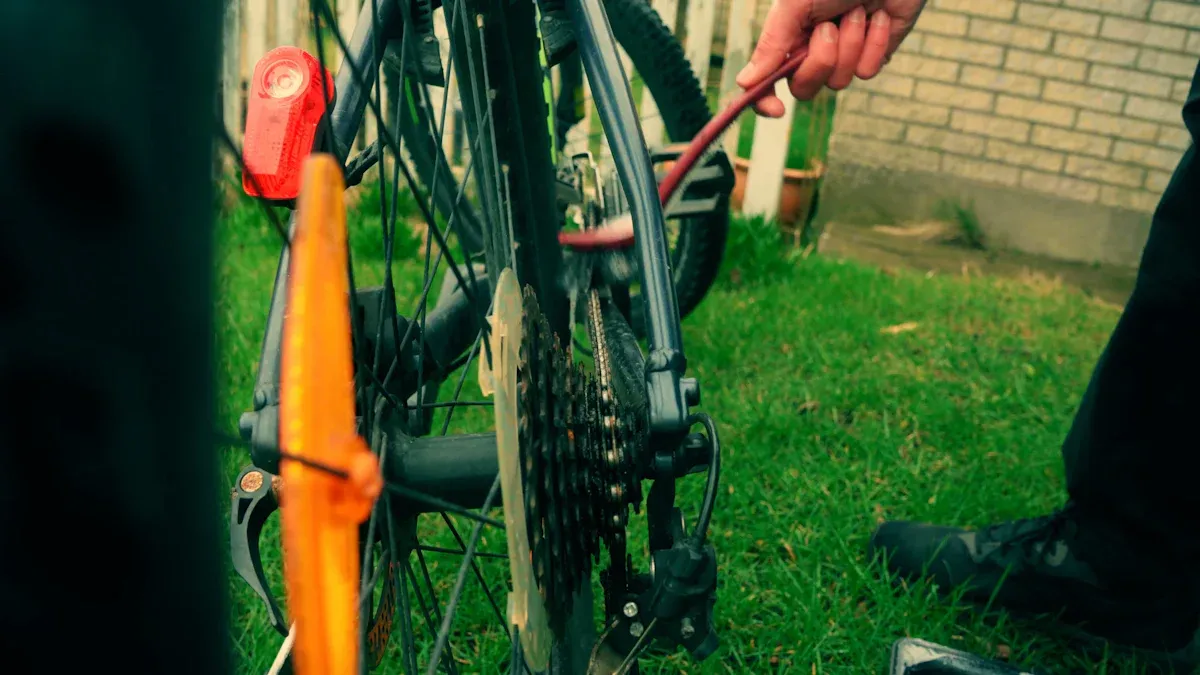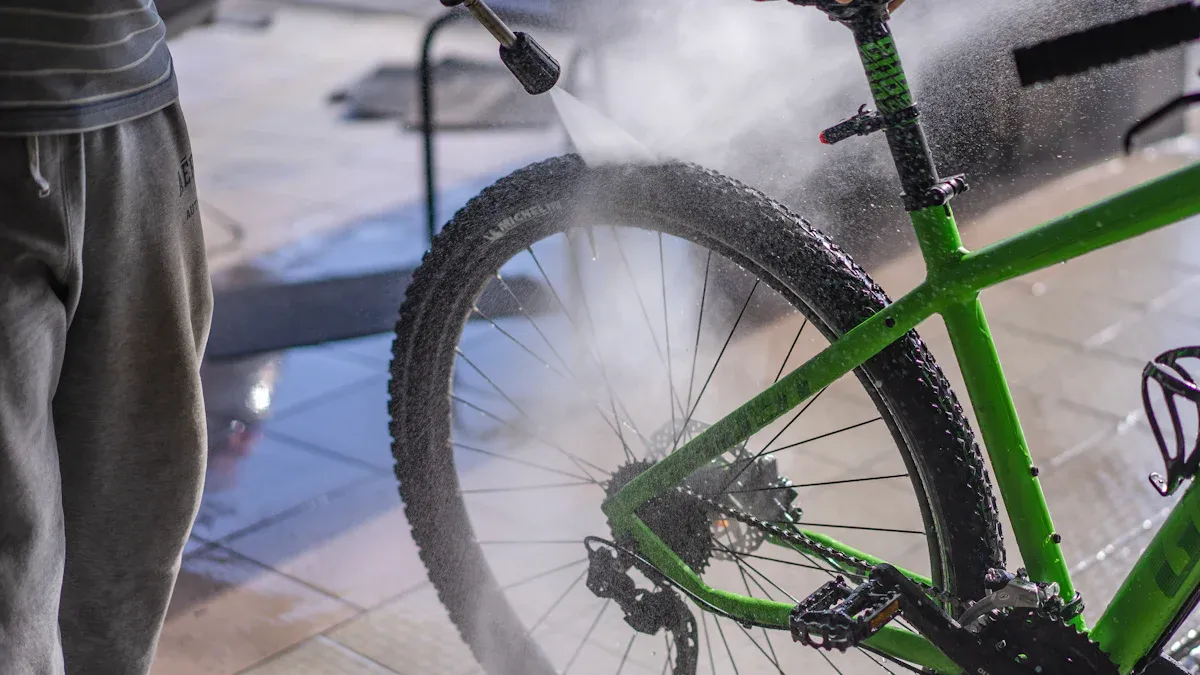
Ever wondered how to choose the right bike washing machine for your ride? Picking the best fit depends on your bike, your cleaning habits, and your space at home. You want a machine that matches your style and keeps your bike safe. Some bikes need gentle care, while others can handle a powerful foam gun. Remember, the right washing machine does more than clean—it protects your bike and gives you everything you need to know for easy cleaning.
Key Takeaways
Pick a bike washing machine that matches your bike type and how you clean. This helps keep your bike safe and gets it clean.
Think about your space and money before you buy a machine. Small and cheap machines are good for small homes.
Choose between manual and automatic washers. Think about how much power, speed, and eco-friendliness you want.
Find machines with nozzles you can adjust and safe pressure settings. This helps you clean your bike gently and not break it.
Read what other users say and look at warranties. This helps you find machines that work well and give good support.
Identify Your Needs
Bike Type
When you start looking for a bike washing machine, think about the kind of bike you ride. Do you have a road bike, mountain bike, or maybe an e-bike? Each type has different parts and needs. For example:
Road bikes have thin frames and need gentle care.
Mountain bikes often get muddy and may need more powerful washing.
E-bikes have electrical parts, so you want to avoid too much water near the battery.
If you have more than one bike, you might want a machine that can handle different sizes.
Tip: Some bikes have better seals and can handle a little more water, but high-pressure washing can still damage bearings and cables. Many riders prefer low-pressure water or soft brushes to keep their bikes safe.
Cleaning Frequency
How often do you find yourself washing my bike? Some people clean their bike after every ride, while others only do it when it looks really dirty. If you ride in the rain or on muddy trails, you might need to clean your bike more often. Frequent cleaning helps prevent mud from scratching the paint or getting into moving parts. If you only wash your bike once in a while, a simple manual washer or a brush set might be enough.
Space and Storage
Think about where you will keep your bike washing machine. Do you have a garage, a small apartment, or just a balcony? Some machines are big and need more space, while others are compact and easy to store. If you have limited space, look for a portable or foldable option. Compact machines work well for city living or small homes.
Budget
Your budget plays a big role in your choice. There are many options, from basic manual washers to high-tech machines. Here’s a quick look at price ranges:
Washing Machine Type |
Price Range (USD) |
Notes on Price Sensitivity |
|---|---|---|
Front-Load Washers |
$650 - $2,200 |
Wide range for different budgets |
Top-Load Agitator Washers |
$380 - $1,600 |
Good for saving money |
High-Efficiency Top-Load Washers |
$515 - $1,200 |
Energy-saving, mid-range price |
Compact Front-Load Washers |
$630 - $2,450 |
Great for small spaces, higher price |
All-in-One Washer-Dryers |
$1,390 - $2,050 |
Premium, does both washing and drying |

You don’t have to spend a lot to get a good machine for washing my bike. Pick the one that fits your needs and your wallet.
Key Features
Cleaning Mechanism
When you look at a bike washing machine, you’ll notice two main types: manual and automatic. Manual machines use your own energy, like pedaling or turning a handle. These work well if you want something simple and eco-friendly. You don’t need electricity, so you can use them anywhere. Usually, you pedal for about 10 minutes to finish a wash. The chain inside helps spin the drum, which makes cleaning easier and reduces stress on your legs.
Automatic machines do most of the work for you. They use a motor to power the cleaning. You just set it up and let it run. Here’s a quick comparison to help you see the difference:
Metric |
Automatic Bike Washer |
Manual Pedal-Powered Washer |
|---|---|---|
Cleaning Efficiency |
Depends on effort, usually lower |
|
Power Requirement |
1 HP engine |
About 1/4 HP (human energy) |
Theoretical Capacity |
231.68 kg/hour |
Lower, based on manual effort |
Actual Capacity |
100 kg/hour |
Lower, based on manual effort |
Efficiency |
44.39% |
Varies, but less than automatic |
Noise Level |
77 dB |
Very quiet |
Engine Vibration |
13.43 m/s² |
None |
If you want a fast and powerful clean, automatic machines give you the best spraying power. If you care about the environment or want to save money, manual machines are a great choice. Some bike-specific options even use less water, which helps you stay green.
Tip: If you ride often or have more than one bike, an automatic bike washing machine can save you a lot of time.
Nozzle and Pressure
The nozzle and pressure settings make a big difference in how well your bike gets clean. The best pressure washers for bikes let you adjust the spray. You can pick a wide spray for gentle cleaning or a solid stream for tough dirt. Here’s a look at how different settings work:
Nozzle Setting |
Pressure (PSI) |
Flow Rate (GPM) |
|---|---|---|
High Pressure Setting |
2.3 |
|
High Flow Setting |
400 |
Higher than 2.3 |
High pressure means more cleaning force, but it can also damage delicate parts. Lower pressure with a higher flow rate is safer for your bike. The best portable washers let you switch between these settings. If you want the best spraying power, look for a pressure washer with adjustable nozzles.
The impact force depends on both the flow rate and the pressure. A solid stream nozzle gives you more power in one spot, which helps with stubborn mud. A fan nozzle spreads the water out, so it’s safer for paint and bearings. Always keep the nozzle a safe distance from your bike to avoid damage.
Note: Bike-friendly pressure washers usually have a PSI rating under 1,500. This keeps your bike safe while still getting it clean.
Compatibility
Not every bike washing machine fits every bike. Some machines work best with road bikes, while others handle mountain bikes or e-bikes. You want a washer that fits your bike’s size and shape. If you have a fat-tire bike or a small kids’ bike, check the specs before you buy.
Many bike-specific options come with adjustable racks or holders. These help you secure your bike during washing. If you have more than one bike, look for a machine that can handle different sizes. This way, you don’t need a separate washer for each bike.
Portability
Do you need to move your bike washing machine around? If you live in an apartment or travel with your bike, portability matters. The best portable washers are lightweight and easy to carry. Some fold up or have wheels, so you can store them in a closet or car trunk.
A portable pressure washer is great for races or trips. You can clean your bike right after a muddy ride, even if you’re far from home. Look for a compact design if you have limited space.
Tip: If you want a washer you can take anywhere, choose a model with a built-in water tank and rechargeable battery.
Power Source
The power source affects where and how you use your bike washing machine. You can pick from three main types:
Manual: Uses your own energy. Good for outdoor use and places without electricity.
Electric: Plugs into a wall outlet. Offers strong cleaning power and works well at home.
Battery: Runs on rechargeable batteries. Perfect for travel and outdoor use.
Electric pressure washers usually give you the best spraying power, but you need an outlet. Battery-powered models are the best portable choice for cleaning on the go. Manual washers are quiet and eco-friendly, but they take more effort.
Note: Always check if your washer’s power source matches your needs and where you plan to use it.
Bike Washing Machine Comparison

Top Models
You have a lot of choices when it comes to picking the best bike washing machine. Some brands stand out because they make cleaning easy and safe for your bike. Here are a few top models you should know:
Brand |
Model |
Type |
Notable Feature |
Price Range |
|---|---|---|---|---|
Pro Bike Washer |
Automatic |
Fast cleaning cycle |
$$ |
|
Muc-Off |
Pressure Washer Kit |
Electric |
Bike-safe pressure |
$ |
Karcher |
OC3 Portable Cleaner |
Battery |
Compact and portable |
$ |
Meitai often gets called the best overall for busy riders. Muc-Off makes one of the best pressure washers for bikes. Karcher is the best overall if you want something small and easy to carry.
User Reviews
People who use these machines share helpful feedback. You can learn a lot from their experiences.
Meitai: Users love the quick wash and sturdy build. Some say it costs more, but it lasts a long time.
Muc-Off: Riders like the gentle spray. They say it keeps their bike safe. A few wish the hose was longer.
Karcher: Many enjoy the light weight and easy setup. Some want a bigger water tank.
Tip: Always check reviews before you buy. Real users can tell you what works best for your bike and space.
Warranty
A good warranty gives you peace of mind. Here’s what you get with these brands:
Meitai: 2-year warranty with fast customer support.
Muc-Off: 1-year warranty. Helpful online help.
Karcher: 2-year warranty. Easy to find service centers.
If you want the best overall value, look for a bike washing machine with a long warranty and strong support.
Bike Washing Tips

Safe Cleaning
You want your bike to look great and last a long time. Safe cleaning starts with the right tools and settings. When you use a pressure washer, always begin with the lowest pressure that gets the job done. This helps protect your paint and delicate parts. Pick a wide nozzle for most of the bike. Wide nozzles spread out the water, so you avoid damage to bearings and seals. Try to angle the spray instead of blasting straight at the frame. This lifts dirt away without forcing water into small spaces.
Before you start washing, test your nozzle and pressure on something less valuable. You can use a piece of cardboard or an old part. Practice makes you better at using the pressure washer safely. If you are new to washing my bike, take it slow and check your results as you go.
Choose a bike-safe spray setting if your washer has one. Use a gentle degreaser for the chain and gears. Rinse well so no soap or degreaser stays behind. Dry your bike with a soft towel to prevent water spots.
Tip: Always clean your bike in a shady spot. Sunlight dries soap too fast and can leave streaks.
Mistakes to Avoid
Some mistakes can harm your bike or make cleaning harder. Here are common things to watch out for:
Using too much pressure. High settings on a pressure washer can push water into bearings or damage paint.
Picking the wrong soap. Household cleaners can strip away grease or harm your bike’s finish. Stick to bike-specific products and degreaser.
Clamping your bike by the frame. This can bend or scratch it. Use a stand that holds the seat post or rear triangle.
Forgetting to rinse off all cleaning products. Leftover soap or degreaser can attract dirt.
Skipping regular washing. Dirt and grime build up over time and make cleaning harder later.
Stay patient and use the right tools. Your bike will thank you with a smooth ride every time.
Decision Checklist
Final Steps
Ready to pick your bike washing machine? Here’s a simple checklist to help you make the right choice:
Know your bike type. Make sure the machine fits your road, mountain, or e-bike.
Think about how often you clean. Choose a model that matches your routine.
Check your space. Pick a washer that fits your storage area.
Set your budget. Decide how much you want to spend before you shop.
Look for adjustable nozzles and safe pressure settings.
Make sure the washer is compatible with your bike’s size and shape.
Consider portability if you travel or have limited space.
Pick a power source that works for you—manual, electric, or battery.
Read user reviews and check the warranty.
Double-check that the machine gives you everything you need to know for safe and easy cleaning.
Tip: Print this checklist or save it on your phone. It makes shopping much easier!
Where to Buy
You have lots of options when it comes to buying a bike washing machine. Retail chains and e-commerce platforms are the most popular choices. Many people like shopping online because it’s fast and you can compare models easily. Big retail stores near family neighborhoods often carry top brands. If you live in a bike-friendly area, you might find more choices at local shops.
Distribution Channel |
Why Choose It? |
|---|---|
E-commerce |
Wide selection, easy comparison |
Retail Chains |
In-person help, instant pickup |
Car Detailing Stores |
Specialized cleaning products |
Bike cleaning products now make up over 60% of the market, so you’ll find plenty of options. The market keeps growing, especially among young riders and families. Try to avoid unknown brands with no reviews or warranty. Stick with trusted names like Meitai, Muc-Off, or Karcher for peace of mind.
You now know how to pick the best bike washing machine for your needs. Start by thinking about your bike, your cleaning habits, and your space. Use the checklist and tips above to help you decide. If you want a reliable option, check out brands like Meitai, Muc-Off, or Karcher.
Remember: The right machine keeps your bike clean and helps it last longer. Happy cleaning! 🚲
FAQ
How often should you wash your bike?
You should wash your bike after every muddy or wet ride. If you ride on dry roads, clean it once every few weeks. Regular cleaning keeps your bike running smoothly and helps it last longer.
Can you use a regular pressure washer on your bike?
Be careful! Most regular pressure washers are too strong for bikes. High pressure can damage bearings and paint. Always use a bike-specific washer or set your washer to the lowest pressure.
What cleaning products are safe for your bike?
Stick to bike-specific soaps and degreasers. Avoid dish soap or harsh cleaners. These can strip away grease and harm your bike’s finish. Look for products labeled “bike safe” for the best results.
Do you need a special washing machine for an e-bike?
Yes, e-bikes have electrical parts that need extra care. Use a washer with gentle pressure and avoid spraying water near the battery or motor. Always check your e-bike’s manual for cleaning tips.


0 comments